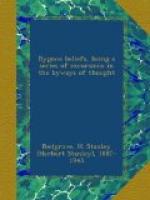Scanned by Charles Keller with OmniPage Professional OCR software
<.> = coordinate covalent bond. <#s> = subscripted #. <#S> = superscripted #. {} mark non-ascii characters. “Emphasis” italics have a * mark. @@@ marks a reference to internal page numbers. Comments and guessed at characters in {braces} need stripped/fixed. Footnotes have not been re-numbered, however, [#] are moved to EOParagraph. The footnotes that have duplicate numbers across 2 pages are “a” and “b”. “Protected” indentations have a space before the [Tab]. EOL- have been converted to ([Soft Hyphen]). Greek letters are encoded in gr brackets, and the letters are based on Adobe’s Symbol font. Hebrew letters are encoded in hb brackets.
Bygone beliefs
being A series of
excursions in the byways
of thought
By
H. Stanley Redgrove
Alle Erfahrung ist Magic, und nur magisch erklarbar.
Novalis
(Friedrich von Hardenberg).
Everything possible to be believ’d is an image
of truth.
William
Blake.
PREFACE
These Excursions in the Byways of Thought were undertaken at different times and on different occasions; consequently, the reader may be able to detect in them inequalities of treatment. He may feel that I have lingered too long in some byways and hurried too rapidly through others, taking, as it were, but a general view of the road in the latter case, whilst examining everything that could be seen in the former with, perhaps, undue care. As a matter of fact, how ever, all these excursions have been undertaken with one and the same object in view, that, namely, of understanding aright and appreciating at their true worth some of the more curious byways along which human thought has travelled. It is easy for the superficial thinker to dismiss much of the thought of the past (and, indeed, of the present) as mere superstition, not worth the trouble of investigation: but it is not scientific. There is a reason for every belief, even the most fantastic, and it should be our object to discover this reason. How far, if at all, the reason in any case justifies us in holding a similar belief is, of course, another question. Some of the beliefs I have dealt with I have treated at greater length than others, because it seems to me that the truths of which they are the images—vague and distorted in many cases though they be—are truths which we have either forgotten nowadays, or are in danger of forgetting. We moderns may, indeed, learn something from the thought of the past, even in its most fantastic aspects. In one excursion at least, namely, the essay on “The Cambridge Platonists,” I have ventured to deal with a higher phase—perhaps I should say the highest phase—of the thought of a bygone age, to which the modern world may be completely debtor.




